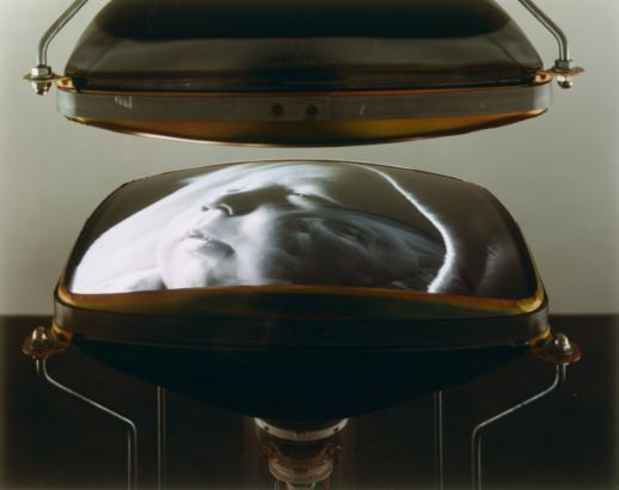“Life & Death” Exhibition
SVA Chelsea Gallery

This event has ended.
“The so-called video image is actually a shimmering energy pattern of electrons vibrating in time. The fabric of the image needs to be in a constant state of motion in order to exist, a modern embodiment of Buddha’s dictum that ‘all existence is change.’ The electronic image is not fixed to any material base and, like our DNA, it has become a code that can circulate freely to any container that will hold it, defying death as it travels at the speed of light.” - Bill Viola
School of Visual Arts (SVA) presents “Life & Death,” an exhibition of works produced over four decades by pioneering video artists Dara Birnbaum, Peter Campus, Frank Gillette and Bill Viola, and curated by MFA Art Practice Department Chair David A. Ross. Ross notes in his curatorial statement, “the exhibition is an attempt to distill a central metaphor found in four very different works, each dealing in its own way with issues of transcendence and mortality.”
First known for her 1978-1979 video mash-up/collage of television actress Linda Carter in the role of Diana Prince transforming into Wonder Woman, Dara Birnbaum is among the first generation of artists to appropriate television imagery, recontextualizing pop icons through fragmentation and repetition to expose the mechanisms of collective memory. By the early 1980’s she began creating complex metaphorical video works, generally eschewing the use of found or appropriated footage. Her 1983 Damnation of Faust explores the eponymous 19th-century myth in a dreamlike, three-part introspection on the duality of interior life and the external world. A playground scene shot in SoHo, close-ups of a woman looking wistfully out of a window and footage of American civil rights demonstrations constitute just some of the imagery through which the artist threads her narrative of loss and redemption.
Peter Campus earned a degree in Experimental Psychology before taking up video in the early 1970s to investigate the role of the spectator and the relationship between illusion and reality. In his 1979 installation work Head of a Man with Death on His Mind—produced shortly before the artist took a 17-year hiatus from making video work—Campus closely frames a face staring directly at the viewer, immobile except for an occasional, monumental (the projected face is 12 feet high) blink of the eyes. The video loops continuously, giving the impression that the man will bear his thoughts of death silently, impassively, forever.
A founding member of the Raindance Corporation, the alternative-media think tank that published the influential Radical Software magazine beginning in 1970, Frank Gillette produces multi-channel video installations, photographic works and single videos in which empirical observations of natural phenomena are reorganized into complex audiovisual compositions. In his first new video installation work since 1984, Conjunction, he stages a conceptual faceoff by placing four identical monitors at right angles to one other. Two screens display nature in its purest form, free of human intervention; the other two document the man-made or synthetic world through “ritualistic assemblies (moving still lives),” as Gillette says. The resulting installation considers “the perpetual conflict and mutual antagonism floating between sovereign nature and the toxic swagger of invading artifact.”
Widely acknowledged as having expanded the scope of video art in terms of technology, probing intellectual and spiritual content and the use of images and motifs from the history of art, Bill Viola began experimenting with sound and visual recording techniques as a teenager and studied visual art and electronic music at Syracuse University in the early 1970s. He and Ross worked together as undergraduates, and then again during Ross’ pioneering video curatorial work at the Everson Museum. His 1992 installation Heaven and Earth is a deeply personal work reflecting his ongoing engagement with archetypal imagery from eastern and western spiritual traditions. The piece consists of two exposed cathode ray (television) tubes separated by only a few inches, one rising from the floor on a narrow pedestal, the other descending from the ceiling. On the lower upturned screen we see the his mother’s eyes closed and in a coma shortly before she died. On the other monitor, the face of Viola’s newborn son is reflected in hers as is his in hers—the two generations who would never meet in life, connected in a shared virtual space.
An advocate for contemporary art and artists for the past 40 years, David A. Ross was director of The Institute of Contemporary Art in Boston, the San Francisco Museum of Modern Art and the Whitney Museum of American Art. Ross has been active in a curatorial capacity since 1971, when he was named the world’s first curator of video art at the Everson Museum of Art in Syracuse, New York. Ross curated Frank Gillette’s first major museum exhibition in 1973, the 1974 solo exhibition of Peter Campus for the Everson, has presented and written about Dara Birnbaum’s work since the early 1980’s, and with Peter Sellars, co-curated the 1997 Bill Viola retrospective at the Whitney Museum of American Art. He has contributed to numerous publications on the subject, including Video Culture: A Critical Investigation (Gibbs Smith, 1987), Video Art: The Castello Di Rivoli Collection (Skira, 2005), and Illuminating Video: An Essential Guide To Video Art (Aperture/Bay Area Video Coalition, 2005).
[Image: Bill Viola "Heaven and Earth" (1992) Video installation courtesy of Bill Viola Studio, Photo: Robert Keziere]
Media
Schedule
from October 17, 2012 to November 17, 2012
Opening Reception on 2012-10-18 from 18:00 to 20:00